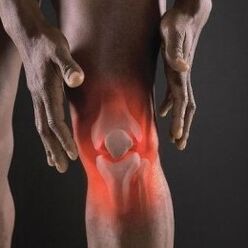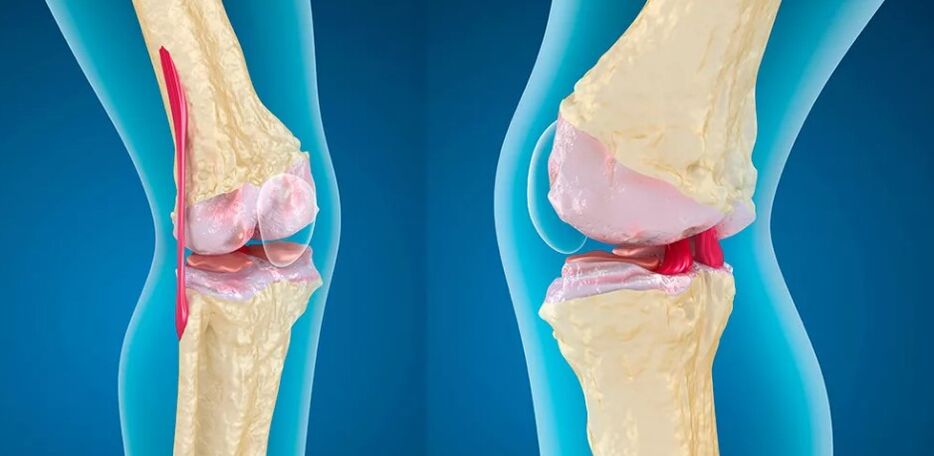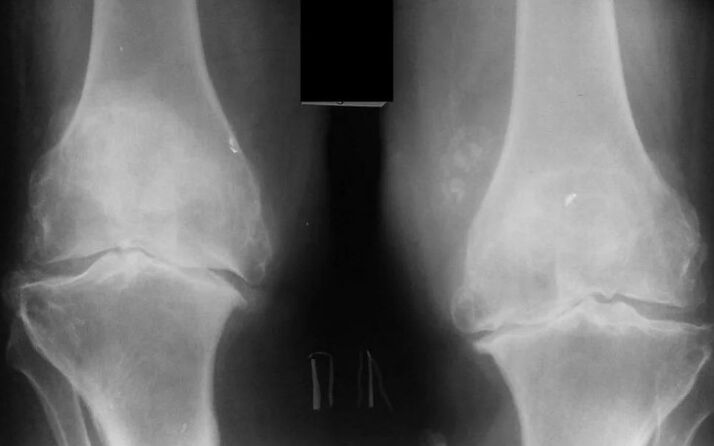Osteoarthritis is a degenerative dystrophic disease of the joints, which is characterized by slow and progressive destruction of the intra -articular cartilage. The osteoarthritis includes a group of joint diseases of destructive anti -inflammatory nature, which have different causes and similar developmental mechanisms.
Arthrosis is one of the most common diseases in the world that takes a leading position in women and men over 30 years, and with increasing age the risk of developing the disease only increases.

The causes of pathology
The arthrosis develops due to a violation of metabolic processes in the joints, in front of which the background, the intra -articular cartilage loses water and does not become elastic. The predisposing factors of such changes in the cartilage can be internal and external causes:
- hormonal changes;
- Age -related characteristics;
- genetic predisposition;
- Rheumatoid arthritis;
- Excessive joint clasting;
- Injuries and damage - transfers, fractures, severe bruises, ligament rupture;
- Changes in the metabolism in the joint in connection with obesity, diabetes mellitus;
- Settlement;
- Inferior and unbalanced diet in which the body does not receive calcium, omega-3 and 6, fats and proteins;
- Inflammation process in the joint;
- Violation of blood supply to the thigh head - Perte's disease;
- Problems with blood clotting, hereditary diseases;
- Autoimmune diseases - Red Lupus, rheumatoid arthritis.
Specific diseases that have nothing to do with the joints, namely: namely: namely:
- Syphilis;
- Hyperthyroidism;
- Thyreoiditis.
People who deal with severe physical work are forced to constantly prevent and to constantly prevent the musculoskeleton-system miner, smithy, athletes, moving and pregnant women.
Symptoms of arthrosis
The first symptom of osteoarthritis is the pain in the slightest load on the joint, which quickly pass as soon as the joint is left alone. Arthrosis is characterized by 4 basic clinical signs:

- Pain - pain in arthrosis have some characteristics, in contrast to pain if the joint or inflammatory process is randomly foiled. First of all, you should pay attention to the occurrence of symptoms and pain for every movement and stress of the affected joint. It is worth a person to move and remove the load because the pain runs immediately, which does not occur in the event of injuries or inflammation of the joint. At night, the collapseing joint practically does not cause any symptoms for the patient, painful sensations only possible if the body position has changed, but they quickly pass. With a pronounced progression of destructive processes in the joint, sharp pain can occur at night, which ultimately become stronger and make their lifestyle adjustments. Acute pain occurs in all weather changes, changing the moon phases, the slightest load.
- Crystal - This sound appears due to a decrease in the softness of the rotation of the bones around the joint, which leads to the friction of the bones and is accompanied by a characteristic crunch. When degenerative processes progress in the joint, the crunch becomes stronger and is accompanied by pain.
- Limitation of the mobility of the joint - in the initial phase of the development of the pathological process of pronounced restrictions on mobility, but as the destruction of the joint progresses, it becomes increasingly difficult for the patient to perform simple acts. Ultimately, the affected joint is completely immobilized.
- The joint deformation - osteophytes begin to actively grow on the surface of the bone, and the synovial fluid accumulates. The deformation of the joint is observed in an advanced pathological process.
Degenerative processes in the joint do not develop quickly, the disease is characterized by the stages of deterioration and remission, from which the patients are in no hurry to seek medical help, which contributes to the progress of destructive processes in the joint.
Level
The phase of the progression of the pathological process in the joint is determined using the X radiation examination. There are only 4 stages of the disease:
- First - characterized by a slight narrowing of the common gap, while there is no pathological growth on the bones;
- The second - there is a slight narrowing of the joint column, osteophytes are formed on the surface of the bone;
- The third - the joint gap is narrowed, the joint is observed on the surface of the bone. The joint is observed;
- The fourth - there is practically no joint gap, there are several osteophytes, a pronounced joint deformation.

degree
Osteoarthritis is expressed in the form of degenerative-destructive processes in the joint, the cartilage is affected, changes in the capsule and the synovial joint of the joint as well as in the ligaments around them and bone structures. Depending on the severity and severity of this destruction, it is common to distinguish 3 degrees osteoarthritis.
The first degree
There is no pronounced deformation or changes in the joint, but the composition of the synovial fluid is disturbed. This leads to inadequate provision of joint tissues with nutrients, water and micro elements, which quickly does not become elastic and is not adapted to the loads. Over time, this causes inflammatory processes and is accompanied by pain during movement and stress onto the joint.
In the first degree of arthrosis, none of their patients seek medical help and leads to discomfort and pain on an unpleasant pose in sleep, tiredness and a false lifestyle. Sometimes the patient can notice a characteristic crunch in the area of the affected joint, but this is not accompanied by severe pain, but only by symptoms that nobody is considered again.
If osteoarthritis is accidentally diagnosed in the first stage, the disease can be easily treated.
The second degree
At this stage, the disease is accompanied by destructive processes of cartilage tissue in the joint. Osteophytes grow intensively on the surface of the bone, and the more intensely the load of the damage zone, the more pronounced the destruction will progress.
At the same time, the patient complains of constant pain in a real nature that passes on at regular intervals and cannot feel for a long time. Then the disease takes place again. Against the background of such a pathological process, the muscles that surround the inflamed joint are gradually losing their functions, from which the patient quickly becomes tired and cannot withstand physical activity, which he slightly endured. In the second degree of arthrosis, the patient gradually pursues the deformation of cartilage and joint.
The third degree
It is the most difficult. The intra -karticular cartilage of the affected joint is thinner and intensely destroyed, which leads to a significant noticeable deformation and impairment of the functions of the affected limb. The ligaments and muscles next to the joint are nutrient deficiency and oxygen and gradually atrophy, which is accompanied by a pronounced loss of mobility. At the same time, the patient is tortured through acute pain all the time, which is reinforced by every attempt to change the position of the body, with changes in the weather conditions and the moon phases and gradually leads to a complete loss of legal capacity.

Types of osteoarthritis
Depending on the cause of the pathological process, primary arthrosis is secondarily and idiopathically differentiated in the joint.
The primary is developed as a independent disease due to an injury or infection, and the cause of the idiopathic form is not known. In addition to the classification of the disease, a distinction is made between the cause of the pathological process arthrosis at the location of the localization of destructive changes:
- Gonarthrosis is the most common type of pathology characterized by damage to the knee gene. Most of the time, gonarthrosis is determined in people with excess weight with chronic metabolic diseases in the body and weak immunity. The knee arthrosis runs for a long time and gradually leads to a complete loss of the motor function.
- The ankle arthrosis - the main causes for the development of degenerative processes in the ankle joint are injuries, transfers, stretching, fractures. In some cases, the development of the pathological process can provoke an autoimmune disease - rheumatoid arthritis. The ankle arthrosis is susceptible to dancers, women who wear high heels, athletes.
- The arthrosis of the shoulder joint is the main cause of degenerative processes in this area.
- Coksart rose or arthrosis of the hip joint - the main cause of the appearance is age -related changes in the tissue of the joint. Endangered, people over 45 years old.
- The osteoarthritis of the cervix region - the causes are neck injuries, progressive osteochondrosis, obesity, a sitting lifestyle. People who work on the computer are danger in offices. In addition to severe pain in the neck, patients have spoken dizziness, consciousness, memory disorder and tiredness. These symptoms are due to the compression of the vertebral artery through which nutrients and oxygen get into the brain.
- Spondylarthrosis - The destructive destruction is subject to tissues of the spine, namely the lumbar department. A woman's risk group during menopause, since spondylarthrosis progresses against the background of a lack of female sex hormones.
- Osteoarthrosis of the fingers - develops for the same reason as spondy arthrosis.
- Polyarthrosis - characterized by damage to several joints with progressive degenerative processes in them, while ligaments, muscles and the surroundings of the tissue are involved in the pathological process.

Treatment of osteoarthritis
The treatment of osteoarthritis is best done in the early stages, then the disease is better conservative therapy methods. It is very important to correctly determine the cause of progressive destructive changes in the joint and to stop these factors in good time.
The treatment of osteoarthritis is carried out comprehensively and is to eliminate the inflammatory process, stop pain syndrome, stop the progression of the pathological process and, if possible, to restore the lost joint functions. Conservative therapy includes the selection of medication and physiotherapy treatment methods.
Drug treatment
The treatment of osteoarthritis differs with different locations of the pathological process:
- Osteoarthritis of the fingers and hands -do not prescribe -steroid anti -inflammatory medication in the form of ointments from cream, gel. In order to prevent the progression of the pathological process, the technique of chondroprotectors is shown. After an acute inflammatory process has been stopped, massage and physiotherapy therapy methods are prescribed.
- With the osteoarthritis of the shoulder joint -im joint -In -the patient is injectively injectively injected pain relievers and non -steroidal anti -inflammatory medication. Oborär can prescribe recording medication that relaxes the muscles and easily reduce the pain intensity. After the relief of acute inflammation and pain, physiotherapy and massage are indicated.
- Osteoarthritis of the knee joint not -steroid anti -inflammatory medication on site in the kind of compresses, ointments, gel. The area of the affected joint shows physiotherapy therapy methods.
- Osteoarthritis of the hip joint - compressed with ointment or gel from the NSAID group impregnated to the area of the lesion and painkillers that are injected into the joint.
- Arthrosis of the knee joint - ointments and gels with an analgesic effect are applied to the damage zone, and after relief acute pain and inflammation, physiotherapeutic treatment methods are displayed.
- Ankle arthrosis - The patient is recommended by strict bed rest with the maximum calm of the affected joint. If the acute inflammatory procedure decreases, physiotherapeutic procedures, baths and massage are prescribed.

Physiotherapeutic treatment
The effective physiotherapeutic methods that are often used in different gravity levels of osteoarthritis include:
- Shock wave treatment treatments are effectively eliminated by the growth of osteophytes, which eliminates the pain and the restrictions on joint mobility.
- The muscle stimulation in the affected joint with electrical this procedure is very effective in patients with pronounced limited mobility and enables them to improve blood circulation in the joint, to accelerate regenerative processes to increase the muscle tone.
- Ozonotherapy - A gas mixture is inserted into the cavity of the affected joint, which takes the patient, the patient is normalized the mobility of the joint and signs of inflammation disappear. Ozone therapy is carried out in courses for the maximum effect.
- Phonophoresis - The impact on the damage area by ultrasound waves using medication. This method for using drugs is much more effective because ultrasound waves provide the medication directly to the lesion.
In addition, physiotherapy treatment includes training therapy, massages, manual therapy, mechanotherapy.
Nutrition of nutrition
The diet with osteoarthritis should be the most balanced and richest of polyunsaturated fatty acids, proteins and trace elements. It is recommended to contain fresh fish, vegetable oils, house cheese, dairy products, meat, fresh vegetables and fruit in the diet.
Flour products and "fast" carbohydrates, chocolate, coffee, alcohol, pork, fat and sharp dishes should be excluded from nutrition.





















